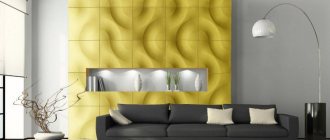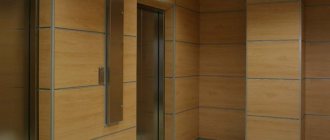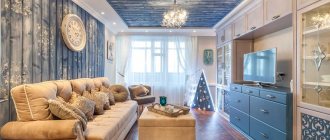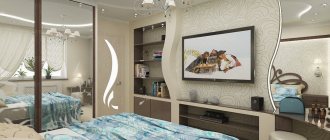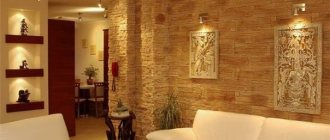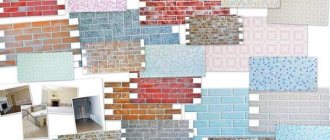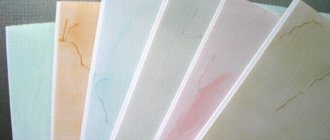Panel selection
The most vulnerable point of a PVC panel is the top wall; the plate has a layered structure like cellular polycarbonate, and the thickness of the top wall is often only half a millimeter.
Such slabs are suitable for finishing the ceiling, but to finish the wall, look for something more serious, otherwise it will be easy to leave a dent on the wall, even just leaning against it.
The width of the slab is usually 25-40 cm, length - 2-3 m.
We do not recommend buying plates that are too wide, especially at small markets, as they could become warped due to improper storage.
Wide range of PVC panels
How to check a pack?
Take out a few pieces, and apply tenon to tenon and groove to groove, if there is an unevenness, you will find it. Also try joining the panels, pressing a little with your fingers to assess the strength of the outer wall, scratching with your fingernail to assess the strength of the coating. The more stiffening ribs, the stronger the plate, and they must be positioned strictly parallel and even.
Carefully inspect each plate; there should be no waves, drops, or other mechanical defects; the plate should have neatly sealed, smooth edges. If everything suits you, we buy it.
Before purchasing, calculate how many panels you will need; it is better to take 1-2 in reserve.
Comparison of sections of PVC panels: On the left are more durable due to the larger wall thickness
What to look for when choosing PVC wall panels
It’s quite easy to get confused in the assortment - PVC is one of the easiest materials to process, after paper, and companies offer a very wide variety of products. Below are tips that, if followed, will prevent you from making mistakes. We will also provide an assortment of PVC wall panels - catalog, photo and price are attached.
Dimensions of PVC panels for walls
The size depends on the requirements, but in general, you need to take into account that it will be inconvenient to work with panels that are too large or small. The sizes change mainly only for tiles and for sheets - the slats have a relatively identical size, which, with rare exceptions, changes.
Varieties and sizes
The length of the slats should preferably be equal to the length of the entire surface to be coated. This will avoid vertical joints. It is better to take with a margin of 200mm, since various errors may appear during measurements and work.
Fire safety
The ignition temperature of this material is approximately 500 degrees. It begins to decompose at a faster rate, therefore, PVC wall panels for interior decoration can be considered a relatively stable material. The greatest danger is the surface coating - often the paints used for panels have a low combustion temperature.
Fire hazard indicators
Typically, the fire safety class is indicated on the packaging, therefore, if you want to create a more fire-resistant room, it is advisable to use the highest possible class in the decoration.
Impact resistance
Impact resistance depends on the structure and thickness of the plastic. The cellular structure is considered the most durable - the partitions act as a shock absorber, and the thickness makes the panels more resistant to bending. Conventional single sheets have less strength - they crack and bend quite easily.
Toxicity
At the moment, all PVC meets quality standards and does not emit harmful substances. The biggest problem can be paints containing lead and other heavy metals, but these are quite difficult to find these days, especially in large hardware stores. If in doubt, the seller must have a quality certificate, which must confirm the absence of harmful substances.
Manufacturer
To produce in this case has a rather conditional meaning. In the regions, as a rule, they sell products from local manufacturers, which vary in quality depending on the technological conditions and the integrity of the manufacturer. At the same time, foreign brands are often obscenely expensive here, and therefore are not always a wise purchase. We recommend that you select products with the best price/quality ratio. In this case, you will get maximum panel life at an affordable price.
Color, texture, pattern
Almost all of these factors depend on the surface application, so its quality should be monitored. Peels, scratches and other defects will lead to very rapid deterioration, so they must be avoided. When placing PVC panels for walls on a balcony, you should look at colorless options - they are better resistant to ultraviolet radiation.
Colors
Price
The cost varies from 150 to 1000 rubles per square meter, and sometimes much more. It all depends on the coating, thickness and structure of each sheet. In this case, cost definitely does not equal quality - all panels are varied and require special treatment.
Mounting options for PVC panels
There are three main ways:
- Glue the panels to the wall with special glue;
- Screw on with self-tapping screws;
- Mount on a metal or plastic sheathing.
If you have smooth walls, you can use the first two methods. Glue is a good option, we’ll talk about glue later, but with self-tapping screws, if the walls are concrete, you’ll have to work hard (and the neighbors won’t be happy either). Before installation without lathing, the walls are leveled with putty, the tubercles and protrusions are cut off with a grinder.
Lathing is done if the surface is uneven (conditionally - differences of more than three millimeters). However, a panel mounted on a sheathing is easier to push through, since there is emptiness behind it. In addition, the sheathing itself takes up space.
How else can you fix PVC panels on the walls?
Although the method described above for decorating walls with plastic panels is not very complicated, it is not suitable for everyone. For example, the walls are perfectly smooth after plastering with beacons or leveling the walls with plasterboard. It is clear that lathing is not needed. It will only take up space. In this case, they violate technology - they glue plastic panels onto silicone or polyurethane foam.
In this case, the starting profiles will still have to be installed, but they will need to be secured to the appropriate dowels. After that, foam (zigzag) or silicone is applied to the back side of the panel (in islands in increments of 10-15 cm), the bar is inserted into the profiles, pressed, and fixed in one or two places with appropriate fasteners. They continue in the same spirit.
The advantage of the method is that it is very fast, the disadvantage is that it only works on smooth (or almost) walls. But the most important thing is that it is simply impossible to remove the finish without destroying the plastic panels.
Fastening to the sheathing
Sheet finishing materials are often mounted on lathing, and PVC is no exception here.
A frame made of galvanized steel is used, where vertical profiles can be positioned in increments of 30-40 cm. It is convenient to use perforated steel tapes for attaching drywall. When installed, they bend to form the letter "P", they are usually about 60 mm wide and are mounted on brackets.
Horizontal profiles are located in increments of no more than 50 cm, usually 40. There must be one profile each at the floor and at the ceiling for attaching the edge of the panel.
They are attached to the base of the wall with self-tapping screws 40-50 mm long, and the vertical profiles are fixed with small self-tapping screws about 10 mm long.
It is desirable that the joining point of the panels be on the profile.
The same is true for horizontal panels; if necessary, a row can be assembled from two pieces, but the joint must be on the bracket. To make it look better, you can use connectors.
Installation of PVC panels on the wall through lathing
Marking
We set the lathing according to the level so that there are no deviations. In order not to display each profile separately, you can make markings on the wall:
- We place the bottom row of the sheathing a couple of centimeters above the floor, this will be the starting point;
- Draw a horizontal line along the level along the entire wall;
- We draw a line under the ceiling in the same way.
- At a height of half a meter (or whatever you have) from the line below we place a starting beacon, and then mark it at a similar interval to the very top.
- Using the level beacons we draw parallel lines along the entire wall.
Instructions for installing PVC panels on the sheathing
Next, we install the sheathing on the walls and the panels on it (for example, using the adhesive method).
Vertical and horizontal methods of installing PVC panels on lathing
Panel texture
Texture is responsible for the relief and appearance of the panels. At the moment, with the help of laser engraving it is possible to achieve almost any texture that will allow you to decorate a room. Among all the diversity, it is worth highlighting the following main areas:
- under a stone;
- under the tree;
- 3D panels;
- mosaic.
They all have their own characteristics that should be taken into account when working.
Under the stone
Stone itself is a very expensive material - its extraction and processing consumes a large amount of resources. PVC panels for walls with a similar texture can currently successfully imitate it. Of course, upon closer examination the truth will be revealed, but such interest arises quite rarely.
Wall under slate
Among such textures, two subtypes can be distinguished - those that require mandatory combination of the pattern and those that do not require it. As a rule, the former most often include slats and tiles, the latter – individual PVC sheets.
Caring for this texture, as well as working with it, does not have any features that should be mentioned separately. It should be noted that it is better not to place highly embossed surfaces on those walls that are constantly experiencing mechanical stress - PVC will not withstand it.
Under the tree
Wood texture is one of the most popular. On the market you can find both relief panels that completely imitate wood, as well as simply pasted or painted options. As a rule, the pattern does not require alignment - especially for slatted options.
Wall cladding with wood-look PVC panels
The use of this type of PVC wall panels for interior decoration is quite extensive - they easily fit into both the interior of apartments and the external decoration of private houses. It is worth paying special attention to products with additional coating made from various plastics, which make it feel like wood.
Just like stone coating, it should not be used in places where it can be constantly exposed to various mechanical forces. This will lead to premature spoilage.
3D panels
This type is a finishing material with a pattern applied to it, which, due to its properties, looks three-dimensional. These panels are a real discovery for interior design, as they allow you to achieve extremely interesting external designs.
3D effect
The assortment depends on the store, but in general it is quite wide. As a rule, they are made in the form of tiles or slats, since large sheets can be extremely difficult to use without disturbing the appearance.
They can be used in any room, but you should remember that plastic panels with a 3D pattern may be too provocative for some rooms and will create too much of a burden on the eye. This should be avoided if possible.
Mosaic
Mosaic options are ordinary panels on which a mosaic pattern is applied. Often a relief element is added to it, which repeats the drawings and their features. The use of mosaics is justified in almost all rooms that are connected with water - in the bath, toilet and kitchen.
Sheet mosaic
Often such drawings require combination - it is necessary that the mosaic elements are not interrupted, otherwise the finished result will not look very beautiful. Speaking about the sizes of individual elements, it should be noted that they can be completely different and, in general, everything depends on the chosen model.
Fastening without sheathing
The best solution would be to glue the panels. The procedure is simple, you don’t need to have any special skills, drill anything, etc. Here we describe how to glue PVC panels to a wall using “liquid nails”, however, you can use other adhesives, we will also look at them.
Arguments against lathing:
- When the panels are glued close to the wall, it is more difficult to make a dent in them; they rest directly on the wall. Voids in the sheathing, on the contrary, facilitate accidental damage to the plates.
- It will be difficult to attach something large and heavy to such a wall.
Selection of adhesive composition
There is, so to speak, enough assortment.
You need to pay attention to the following:
- Moisture resistance;
- Resistance to significant temperature changes;
- Hardening speed and reliability of fixation;
- Transparency of the dried composition (if this matters to you)
We immediately discard hot-melt adhesive, since it has a high coefficient of thermal expansion.
You can use “liquid nails,” adhesives for polyvinyl chloride, and polyurethane sealants.
The following compositions performed well:
Kleyberite
German formulation based on artificial resins.
- Resistant to dampness
- Homogeneous in consistency
- Economical consumption
- Quick drying
- Ecologically pure
- Different packaging
Glue – KLEIBERIT
Emphicol
Manufactured in Russia, designed for gluing polymers. It is transparent and, after curing, holds the panel well on any rough surface.
- Suitable for various substrates
- Moisture-resistant, withstands temperature changes
- Resistant to condensation
- Quick drying
- High strength
Moment Crystal
It has good adhesive properties and is colorless. Often used for installation of various plastic structures and suspended ceilings.
Glue – Moment “CRYSTAL”
Tital Wild
A solution of polyvinyl acetate copolymers in a solvent (judging by the smell - ethyl acetate). Good glue too.
Glue TITAN WILD
Liquid Nails
Instead of glue, formulations based on synthetic rubbers under the general name “liquid nails” are also suitable for our purposes. An almost universal product, compatible with many surfaces.
Using liquid nails, you can glue plastic parts, therefore, PVC panels will also stick to the wall.
Types of liquid nails
There are two formulations on the market:
- Neoprene, contain organic solvents. They have good adhesion properties and are resistant to dampness and temperature changes. Users note a rather persistent specific smell that lasts for a couple of days.
- Acrylics are water-based, they are more environmentally friendly, but less practical: they are afraid of water.
Titan Wild
This type of liquid nails is used not only for PVC, but also for heavier structures (plasterboard, metal, cement sheets). Used for ceiling plinths. It is mechanically stable after hardening and is not afraid of temperature changes.
Liquid nails – TITAN WILD
Quality
Professional formulation used in construction and finishing. The color after hardening is white, which somewhat limits its applicability in the installation of PVC panels. Dries quite quickly.
You can determine whether the glue is suitable for you on a small piece of surface: take a piece of plastic and glue it to the base according to the instructions. In a day, tear it off, and everything will become clear.
Liquid nails – QUALITY
PVC panels for walls - advantages and disadvantages
PVC wall panels are polyvinyl chloride sheets pressed into a special shape. They are intended for finishing walls and ceilings and are an extremely convenient material. At the moment, production has gone far ahead, and PVC can imitate various patterns and textures - from wood to tiles or marble.
Speaking about the advantages of this finish, it is worth highlighting:
- waterproof;
- ease of use;
- low cost;
- high durability.
Almost all types of thick plastic are waterproof. The majority of panels are plastic slats, tiles or whole sheets of homogeneous material that does not allow water to pass through. If there are no various gaps between them, then such a wall covering does not allow water to pass through.
Covering walls with PVC panels is much more convenient than tiles or other similar materials - the products can simply be glued to the walls without particularly leveling the surface. By the way, leveling them is also quite simple - just align the slats and glue them to a thick layer of glue, which will act as a kind of balance.
PVC panels cost quite little - especially when compared with other finishing materials. A square meter can reach up to 150-200 rubles, which definitely allows you to save on finishing the room. Given their properties, this makes them a real boon for any builder.
With some exceptions, plastic is very durable - panels made from it can last for many years. At the same time, taking into account the possibility of washing by any means and extremely low soiling, it can rightfully be considered the most stable cheap material for finishing, after wood and stone, of course.
Various colors
The disadvantages include:
- low naturalness of the surface;
- in some cases - rapid fading;
- inability to withstand high temperatures.
Despite high-quality processing, modern options do not always look truly natural. Sometimes you have to try very hard to choose the type of panels that completely imitates the required surface.
Fading depends on the type of paint, but in general it happens quite quickly. This is due to ultraviolet radiation, which destroys the surface layer
High temperatures destroy any plastic. Such panels should not be placed near sources of high temperatures - for example, near gas or electric stoves. Induction cookers will not cause any harm to plastic - heat generation methods rarely affect the wall covering.
How to glue PVC to a wall using liquid nails
So, the materials have been purchased, installation can begin. Here are step-by-step instructions on how to attach panels to the wall in the bathroom (and not only in the bathroom).
1 - Surface preparation
It is worth doing this step with due care.
The old coating is completely dismantled, leaving bare concrete. All recesses are sealed with putty. All tubercles must be cut off with a grinder, a drill with a special attachment, or cut down with an ax.
There should be no differences of more than three millimeters.
Then the surface is prepared: first, treatment with an antiseptic, then with a primer (concrete-contact is optimal, and in two layers). After everything is dry, you can start.
2 - Preparing the panels
Before starting work, it is recommended to keep the plates indoors for 6-12 hours.
Make a marking with the expected location of the plates, level.
Now you need to adjust the panels to the height of the ceiling.
Note! The panel should be cut from the front (front) side, this is necessary so that there are no burrs on the outside.
When using corners and framing profiles, glue them first. To better glue the panel to the wall, we recommend degreasing it from the back with a solvent.
Cutting PVC panels
3 - Gluing technology
Installation of PVC panels on walls. Let's look at how to secure panels using “liquid nails”.
First you need to prepare materials and tools:
- Panels - unpack, bring into a warm room for at least a couple of hours;
- Liquid nails and a gun for them (usually one tube is used for 5-6 m2)
- Sealant (seal seams)
- Wet sponge (remove excess glue)
You can apply liquid nails either to a wall or to a panel. Apply in dots or zigzag, distance no more than 30 cm.
Options for applying adhesive composition
The heavier the plate, the more glue it will require.
If you have already installed corners and profiles, insert the plate into the previously prepared place.
If there are none, then we start from the corner. To glue the panel, press it firmly against the wall, strictly in accordance with the markings, and roll it with a rubber roller.
You have 1-3 minutes to adjust the position of the panel.
When 15-20 minutes have passed, it will no longer be possible to move the panel, as the glue will set, so you need to attach the panels carefully and quickly enough. The glue sets completely within a day.
Now on to how to insert the last PVC panel onto the wall. Option two:
a) There is a starting profile. Then the panel must be trimmed evenly along its length, best with a jigsaw or a metal saw. We leave a piece the width from the wall to the edge of the front surface, subtracting a centimeter gap for installation. The cut edge will go to the penultimate panel, and the remaining edge will go into the profile groove. We don’t install the profile itself yet, we insert the panel into it, then we bend the panel and insert it into the groove. After that we set up a profile.
b) There are no starting profiles, then we simply cut the panel to fit the width of the wall and coat the joint at the corner between the panels with silicone sealant. Those. one panel will go to the wall, the second - to the panel perpendicular to it.
Note! If the width of the wall does not fit an even number of panels, then it will look much more aesthetically pleasing if there are trimmed panels of the same width on both sides.
4 - Final stage
Final finishing. We remove the remaining adhesive from the front side.
The seams between the panels, as well as the joints with the floor and ceiling, can be treated with transparent silicone sealant - it will visually mask the gap and give the cladding additional tightness. Or you can use decorative closing profiles.
Material selection
Naturally, you want to quickly cover the walls with plastic panels, but you need to select them first. And this should be approached with the utmost care. After all, the final result depends on the correct choice. The following rules are taken into account:
- For bathrooms and shower rooms, as well as for all types of wet rooms, panels that are moisture resistant and have no relief are suitable.
- For corridors and balconies (loggias), it is better to choose products that are resistant to mechanical damage.
- Wall decoration with wall panels in living rooms is carried out with PVC coatings, which have different reliefs and patterns. They also imitate natural materials.
Plastic lining has good moisture resistance, so it is often used for finishing bathrooms.
When purchasing, you need to pay attention to the following indicators:
- Appearance of the packaging. It must be intact, without damage. It is important to choose material from the same batch.
- Number of cells. The bigger, the better. You can also navigate by weight. Light products are a sign of deficiency.
- Lock. To do this, check the two selected panels for connection - it must be reliable.
- Price. Products that are too cheap are most likely a fake.
Additionally, we suggest watching a video that explains how to select and attach wall panels.
Common installation mistakes
When installing such panels, the main mistakes are:
- Incorrectly selected glue. We recommend using specially developed adhesives for PVC; if the composition is not suitable, the panels will begin to peel off in a few months or weeks.
- Using glue that is not resistant to water in damp areas. In this case, the panels will peel off within a few days after installation.
- Do not mount panels with a bend. In a fixed position, such panels may look unsightly. Frequent bending will cause the slab to begin to crack and break.
- Incorrectly cut plates. The tooth pitch of the hacksaw should be no more than 0.1 mm, otherwise nicks may remain on the surface of the plate.
- Inappropriate use of solvents to remove glue, stains or dirt. They must be used very carefully, otherwise noticeable marks will remain on the panel.
As you can see, installing PVC panels is not the most difficult task. The main thing is to choose the right materials, make the markings correctly and work carefully.
Characteristics of PVC panels
What kind of material is this? PVC wall panels are sheet material made from polyvinyl chloride or plastic. Scope of use: finishing of premises indoors and outdoors, by cladding walls and ceilings. The rooms can be any. Most often these are: kitchen, bathroom, corridor, balcony. The appearance is varied, this applies to both colors and surface textures.
Plastic wall panels have the following advantages:
- Protection from moisture. They can even be washed.
- Light weight PVC panels. They do not load the structure of the house and are easier to work with/transport.
- Ease of operation. Installation of wall panels is simple, even a beginner can handle it.
- Affordable price. Everyone will be able to afford PVC finishing.
- Long operational period.
- Huge range of products. You can easily find decorative PVC panels to suit your taste and fit any interior.
- The quality of the walls is unimportant, since the installation of PVC panels requires the presence of a frame. It hides wall unevenness and other defects.
- Excellent maintainability. If one product is damaged, it can be easily replaced with another.
- The material is not afraid of temperature fluctuations.
This is what made PVC panels for interior wall decoration so popular. As for the minuses, there are several of them:
- Insufficient strength against mechanical stress;
- Supports combustion;
- Burns out when exposed to UV rays;
- Unnatural material.
Taking into account the fact that it is not necessary to hire a team of workers for installation work, the cost of repairs will be low.

